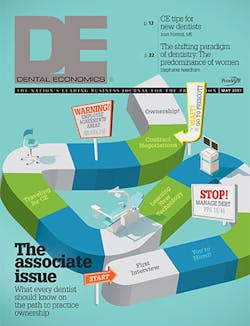Safety and efficiency for instrument management
The day-to-day management and organization of instruments is an often overlooked aspect of both safety and efficiency in dental practices. It is easy to get caught up in the busyness of treating patients, potentially overlooking safety issues that can lead to injuries. One area of concern is transporting and handling instruments during cleaning and sterilization. Similarly, it is easy to overlook inefficiencies in organizing, cleaning, and sterilizing instruments.
Safety in instrument handling begins with minimizing the handling of instruments that are sharp and contaminated from treatment. The Occupational Safety and Health Administration (OSHA) Bloodborne Pathogens Standard1 mandates that contaminated, sharp instruments be transported in closed, puncture-resistant containers. Although moving instruments from the treatment room to the instrument processing area in a typical dental facility doesn’t usually involve long distances, accidents can happen if instruments are carried in hand or on an open tray, which could result in an injury to a team member. In addition, the Centers for Disease Control and Prevention recommends minimizing the handling of contaminated instruments to prevent injuries to dental team members, especially hand scrubbing.2,3
Dental teams have a number of options for safe transport of contaminated instruments. If a practice uses plastic trays, snap-on lids are available to place on the trays, preventing instruments from spilling off the tray while a team member is walking with the tray. In addition, many box-type containers and cassettes are available for enclosing the instruments.
While the tray lids and the boxes minimize the safety concerns and meet the OSHA requirements, they don’t necessarily address the efficiency issues in instrument processing. For example, if boxes are utilized, the instruments must be picked up from the tray and placed in the box after treatment, and if the instruments are cleaned in the boxes, they may have to be removed from the box for rinsing and inspection after cleaning. In contrast, instruments that are arranged in cassettes are arranged in one layer, making it quick and easy to rinse and inspect the instruments for any remaining debris.
If a dental practice aspires to achieve maximum safety and efficiency, instrument cassettes are the optimal choice. Once the size and configuration of the cassettes is determined, the instruments only leave the cassette during treatment (or sharpening, if hygiene instruments). The cassette serves as the delivery system in the treatment room, and once the procedure is complete, the cassette is closed for transport and then placed in an ultrasonic cleaner or instrument washer. After rinsing and inspecting the instruments, the cassette is packaged and placed in the sterilizer and then into storage until the next use. This system of instrument management eliminates the handling and sorting of contaminated instruments during the cleaning and packaging processes, saving time and increasing safety. The time savings may be as much as five to 10 minutes per procedure, which also includes setup time in the treatment room.
There are several factors that need to be considered when implementing a cassette system in a dental practice. The first is the size and configuration of the cassette and standardization of procedure setups. Second is the capacity of the ultrasonic cleaner or instrument washer to make sure that the cassette size can be accommodated. The same applies to the sterilizer, making sure that the chamber size is adequate for the size of the cassettes. This may require an investment in new equipment as well as the cassettes. However, that investment can be quickly recouped by increasing productive time and spending less time processing instruments. One manufacturer of cassettes, Hu-Friedy, has online resources to assist dental practices in configuring their instrument management system and to determine the size and type of ultrasonic and sterilizer needed for the cassettes, streamlining the implementation process with a more efficient and effective instrument management system. Company representatives can readily facilitate this process for dental teams.
Instrument management can be disorganized and labor intensive, or it can be efficient, safe, and economical for dental practices. The key differences are good planning and utilizing instrument cassettes.
Mary Govoni, MBA, RDH, CDA, RDA, is an internationally recognized speaker, author, and consultant, working with dental teams for more than 40 years on clinical efficiency, infection prevention, ergonomics, and team communication. She has published numerous articles in Dental Economics, The Dental Assistant Journal, RDH Magazine, Dentistry Today, Inside Dentistry, and others.
REFERENCES
1. Occupational safety and health standards: toxic and hazardous substances. Occupational Safety and Health Administration website. https://www.osha.gov/pls/oshaweb/owadisp.show_document?p_id=10051 &p_table=STANDARDS. 29 CFR 1910.1030. Published Dec. 6, 1991. Accessed April 18, 2017.
2. Guidelines for infection control in dental health-care settings—2003. Centers for Disease Control and Prevention website. https://www.cdc.gov/mmwr/preview/mmwrhtml/rr5217a1.htm. Published 2003. Accessed April 18, 2017.
3. Summary of infection prevention practices in dental settings: Basic Expectations for Safe Care. Centers for Disease Control and Prevention website. https://www.cdc.gov/oralhealth/infectioncontrol/pdf/safe-care.pdf. Published March 2016. Accessed April 18, 2017.
